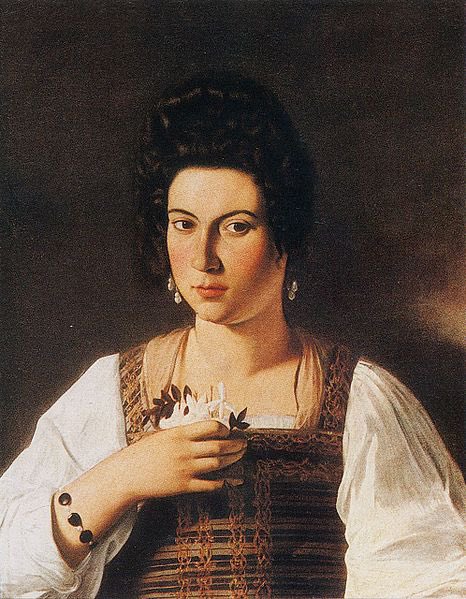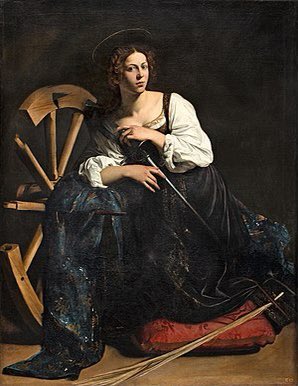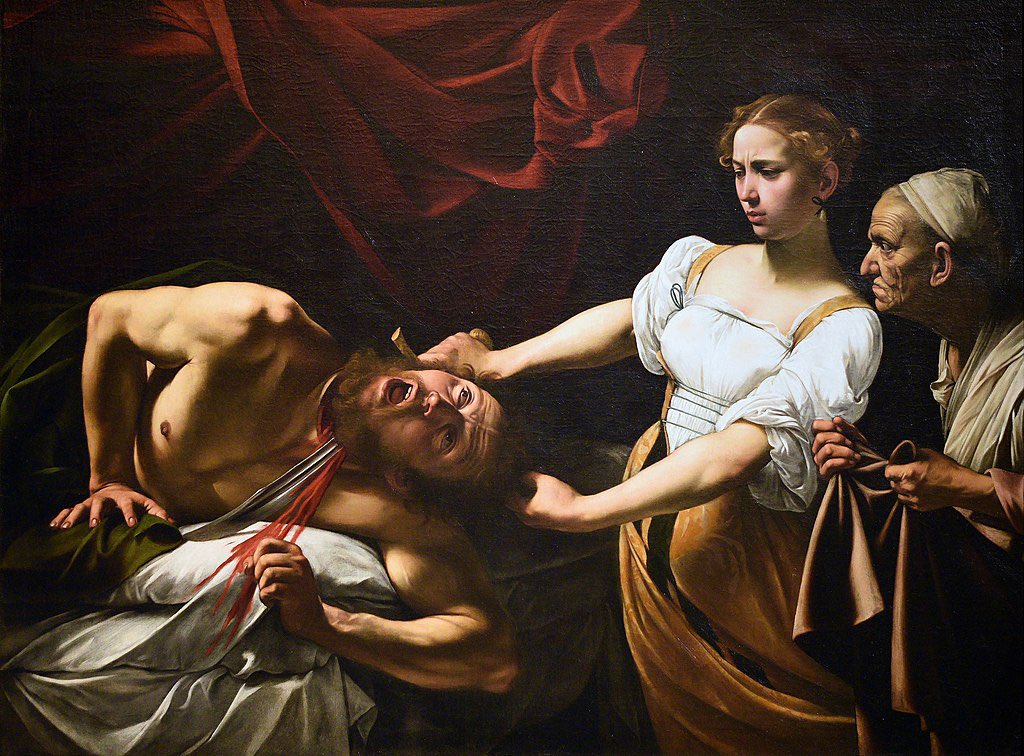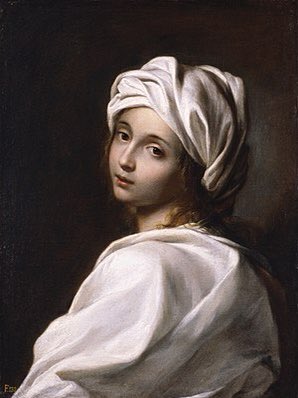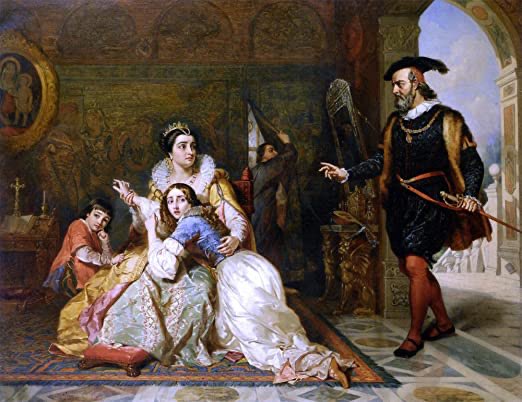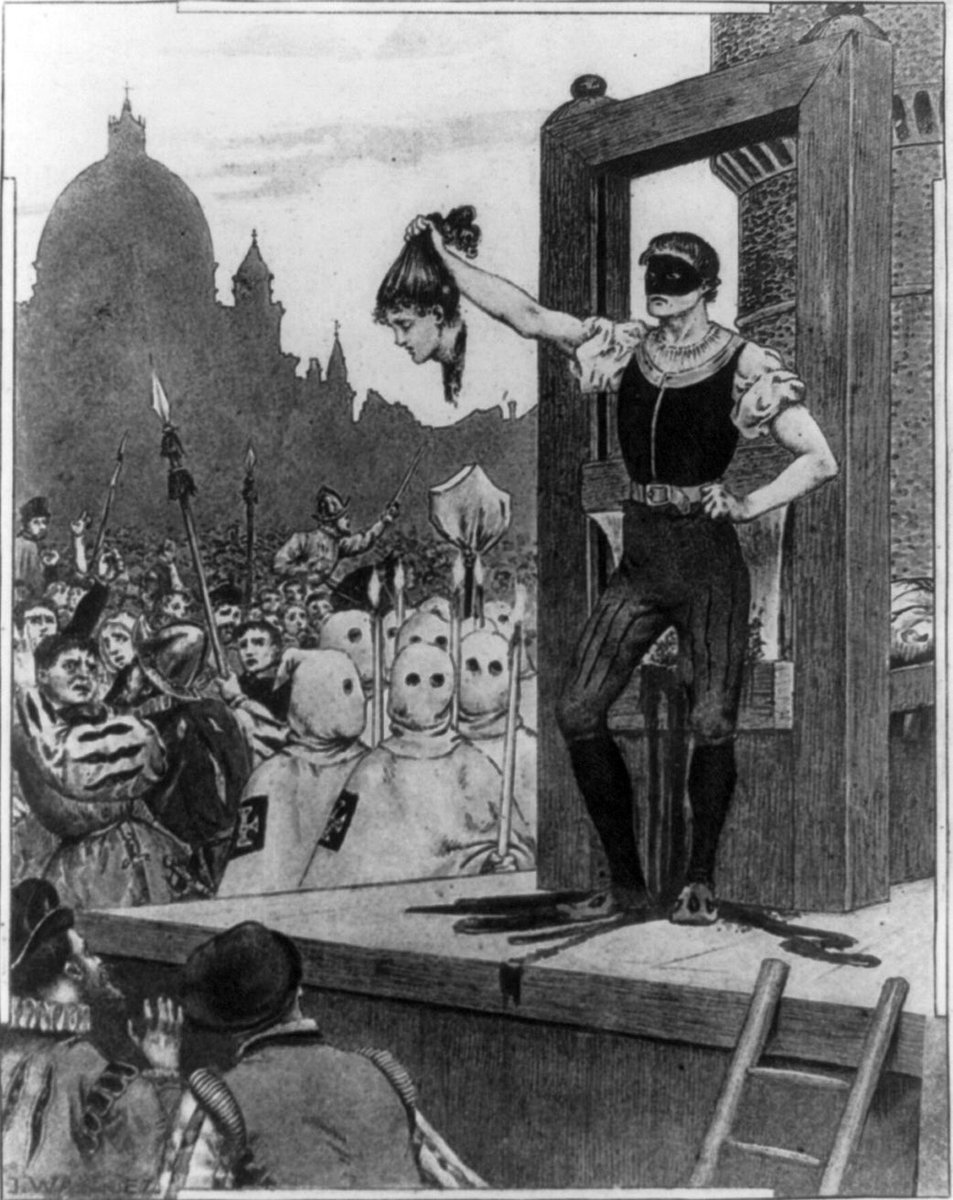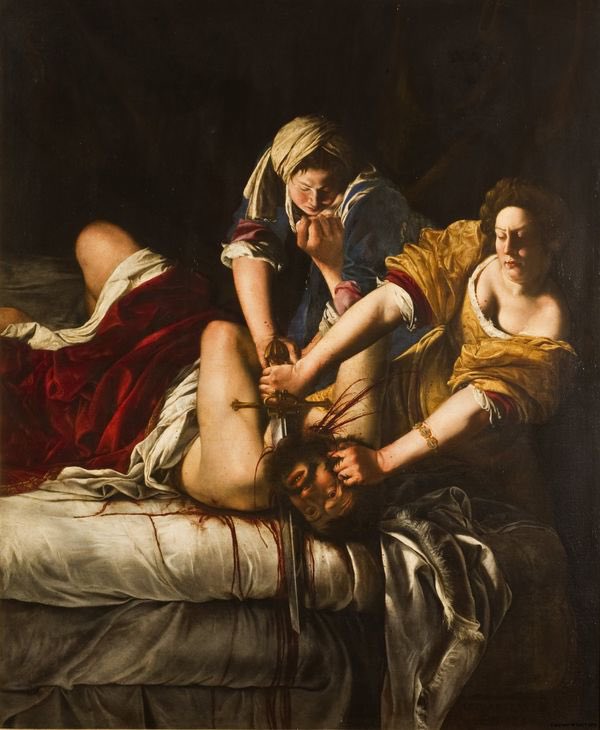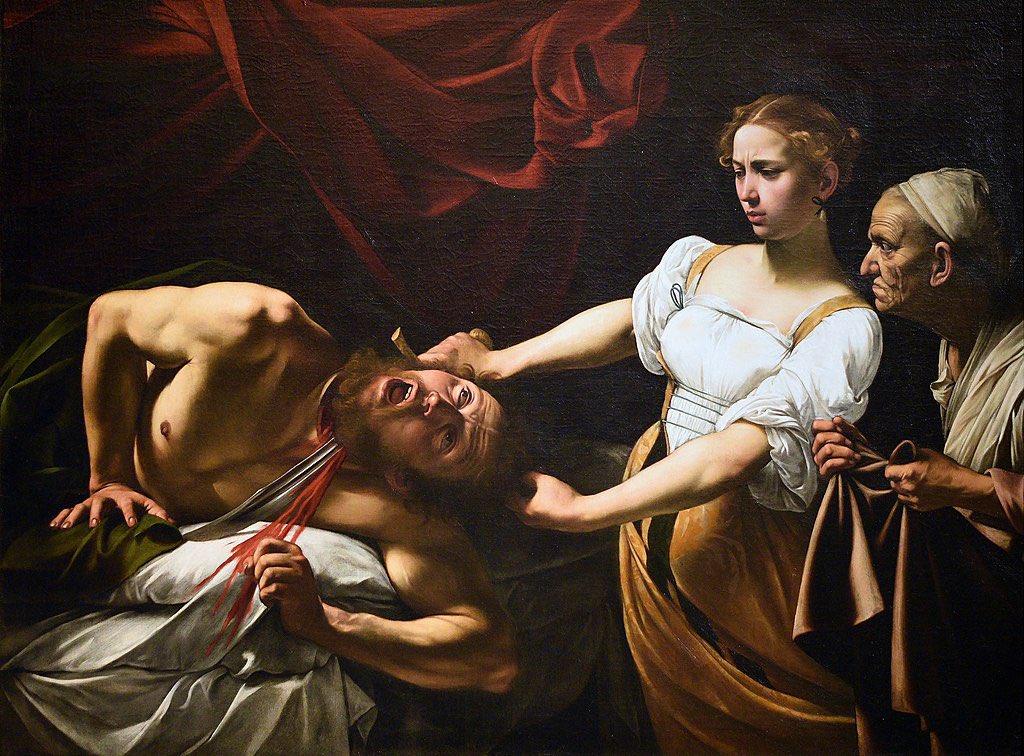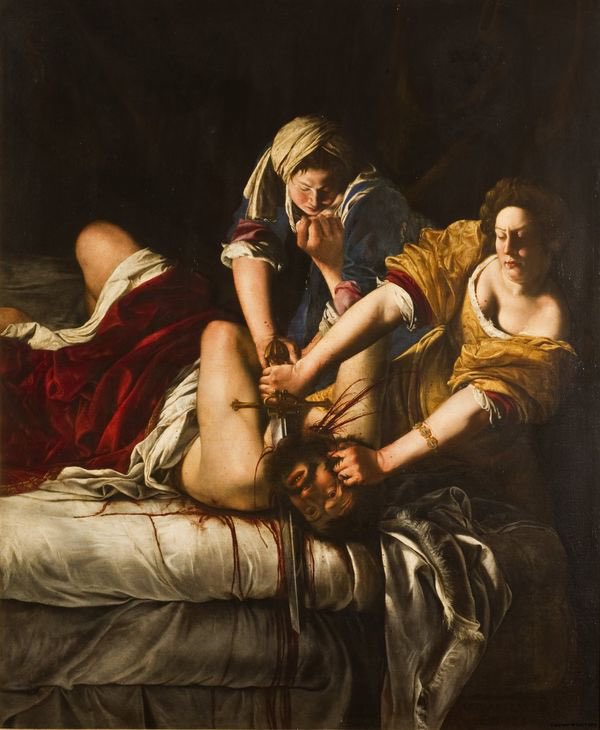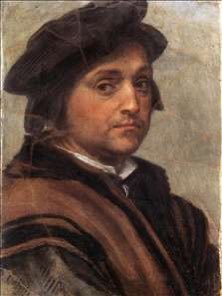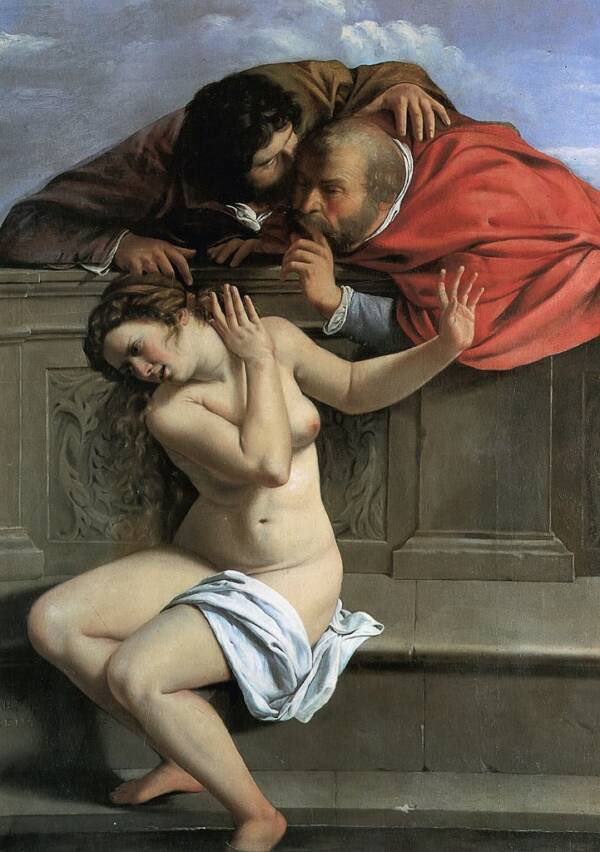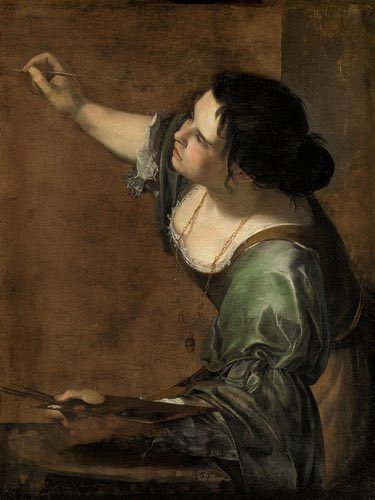This is Judith Beheading Holofernes by Caravaggio, c.1598. It’s one of the most dramatic & famous paintings of the Renaissance. Beyond the mighty Caravaggio, the tragic stories of three Italian women are combined within it.
A thread
(CW. Sexual violence, murder & torture)
A thread
(CW. Sexual violence, murder & torture)
The painting depicts the biblical story of Judith who seduced Holofernes, the Syrian General who was invading her homeland. Once she had gained his trust, she got him drunk and then beheaded him.
STORY ONE, THE MODEL. The model Caravaggio used for Judith was the beautiful & famous courtesan, Fillide Melandroni (1581- 1618). Fillide was born in Siena, but grew up in Rome after her father died. Her mother put Fillide to work in a brothel as a young teenager.
Her first recorded brush with the law was in April, 1594, where she was arrested with another girl for soliciting in the street, rather than a state owned brothel. She was 13 years old. This was the first of many such run ins with the authorities.
Fillide became one of the most famous & in demand courtesans in Italy. Her clients included some of the richest men in Rome, including the banker and art collector Vincenzo Giustiniani who was the patron of Caravaggio.
Fillide posed for him several times. She was the model for (left to right) Portrait of a Courtesan, as Saint Catherine, Mary in Martha and Mary Magdalene, and, of course, as Judith in Judith Beheading Holofernes.
Fillide was celebrated, but she has a volatile temper that often landed her in trouble. She has a longterm relationship with Ranuccio Tomassoni, who was probably her pimp. She was arrested several times for carrying weapons.
The Vicariate of Rome declared Melandroni a "cortigiana scandalosa" (scandalous courtesan)in 1599 for refusing the sacrament. In 1600 she attacked another courtesan Prudenza Zacchia when she found her in bed with Tomassoni.
Witnesses report Fillide screaming “Ah, you slag, you baggage, there you are! Whore, I’m going to scar you everywhere.”
In 1606, Caravaggio killed Tomassoni. The two men fought after a game of tennis and Caravaggio stabbed Tomassoni in the thigh, severing the femoral artery.
In 1606, Caravaggio killed Tomassoni. The two men fought after a game of tennis and Caravaggio stabbed Tomassoni in the thigh, severing the femoral artery.
The reasons remain unclear, but it may have been linked to Fillide. In 1612 Melandroni was forced to leave Rome by the family of Venetian poet, Giulio Strozzi, & one of her clients. When she died in 1618, aged thirty-seven, the Church refused to give her a Christian burial
STORY TWO, THE MURDERER. It is thought that Caravaggio was moved to paint a beheading after witnessing the execution of Beatrice Cenci (1577-99(, a young noblewoman. This painting of her is attributed to Reni or Sirani, and is supposedly from life.
Beatrice was the daughter of Ersilia Santacroce, and Count Francesco Cenci, a violent & deeply abusive man. Her mother died when she was just 7 & her father was quickly remarried to Lucrezia Petroni.
Count Cenci abused his second wife, as well as his sons. He raped his Beatrice multiple times. His abuse was no secret as he had been jailed and fined for other sexual offences. But due to his noble status he was always freed early. (The admonishment of Beatrice Cenci , 1853)
Beatrice desperately tried to inform the authorities about the abuse, but nothing happened. In fact, when he found out that his daughter had reported him, he sent Beatrice and Lucrezia away from Rome to live in the family& #39;s castle at La Petrella del Salto as virtual prisoners.
Unable to endure any more, Beatrice, her two brothers Giacomo and Bernardo, and her stepmother Lucrezia, decided they had to kill Count Francesco.
In 1598, during a visit to the castle, the family drugged him and then bludgeoned Francesco to death with a hammer. Then they threw the body off a balcony to make it look like an accident, but no one believed the death was an accident.
The papal police arrested one of the vassals who had been there that night (and who was Beatrice’s lover). He was tortured for days & eventually killed but refused to talk.
Despite the lack of a confession, the whole family was arrested, tried & sentenced to death by Pope Clement VIII. Francesco was known to be an abuser & the sentence caused outrage, but the pope would not relent. (Statue of Pope Clement VIII in the Borghese Chapel of Santa Maria)
At dawn on 11 September 1599, they were taken by cart to the Sant& #39;Angelo Bridge, where the scaffold was usually built. The older brother, Giacomo had his head was smashed with a mallet, before being cut into quarters.(Execution of Beatrice Cenci, 1895)
Lucrezia and Beatrice were both beheaded with a small axe, which took much longer. The younger brother Bernardo was only 12 and was spared death, but he was forced to witness the execution of his family. All his property was taken by the Pope& #39;s own family.
Caravaggio was in the crowd that day and witnessed the executions.
STORY THREE, REVENGE. This is “Judith Beheading Holofernes” (c.1620), by Artemisia Gentileschi (1593-1653). Artemisia was the most successful female artist of the renaissance & drew considerable inspiration from Caravaggio’s work.
When we compare the two images side by side, it is striking just how much more violent & powerful the women in Artemisia’s interpretation are.
It is thought that Artemisia’s own experiences with sexual violence was a motivating factor in her approach to depicting this story. In 1611, she was 18, Artemisia was raped by her art tutor, Agostino Tassi.
The only way she could hope to avoid to marry someone now she was no longer a virgin was if Tasso agreed to marry her, which he did but quickly reneged on the agreement.
Furious, Artemisia’s father pressed charges for breach of contact and because she had been a virgin, a charge of rape was brought (such a charge would not have been possible if she was not.)
Unusually for the 17th century, Artemisia testified in court against her attacker. In order to ‘prove’ if she was telling the truth, she was tortured with thumbscrews. Tassi not tortured, but he was convicted. Being a close friend of the Pope, he was soon set free.
Following the trial Artemisia married a little-known Florentine artist by the name of Pierantonio di Vincenzo Stiattesi, and left Rome for Florence shortly thereafter. The couple and 5 children and Artemisia went on to become one the the most successful artists of her generation
When she was commissioned to contribute an image to the ceiling of the Casa Buonarroti in 1615, she was paid more than three times any other artist who was working on that series - and she painted it while heavily pregnant.
A reoccurring theme in Artemisia’s work strong women and revenge. This is her painting of the Old Testament story of Jael killing Sisera.

 Read on Twitter
Read on Twitter
